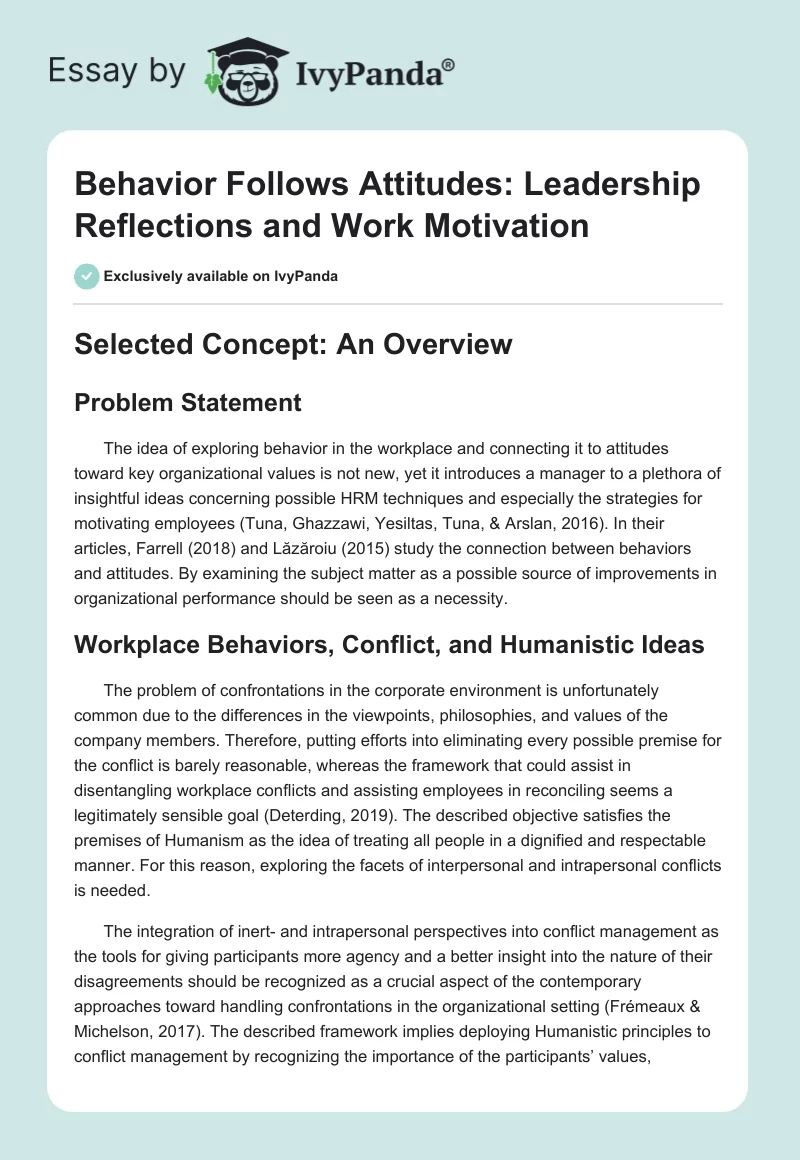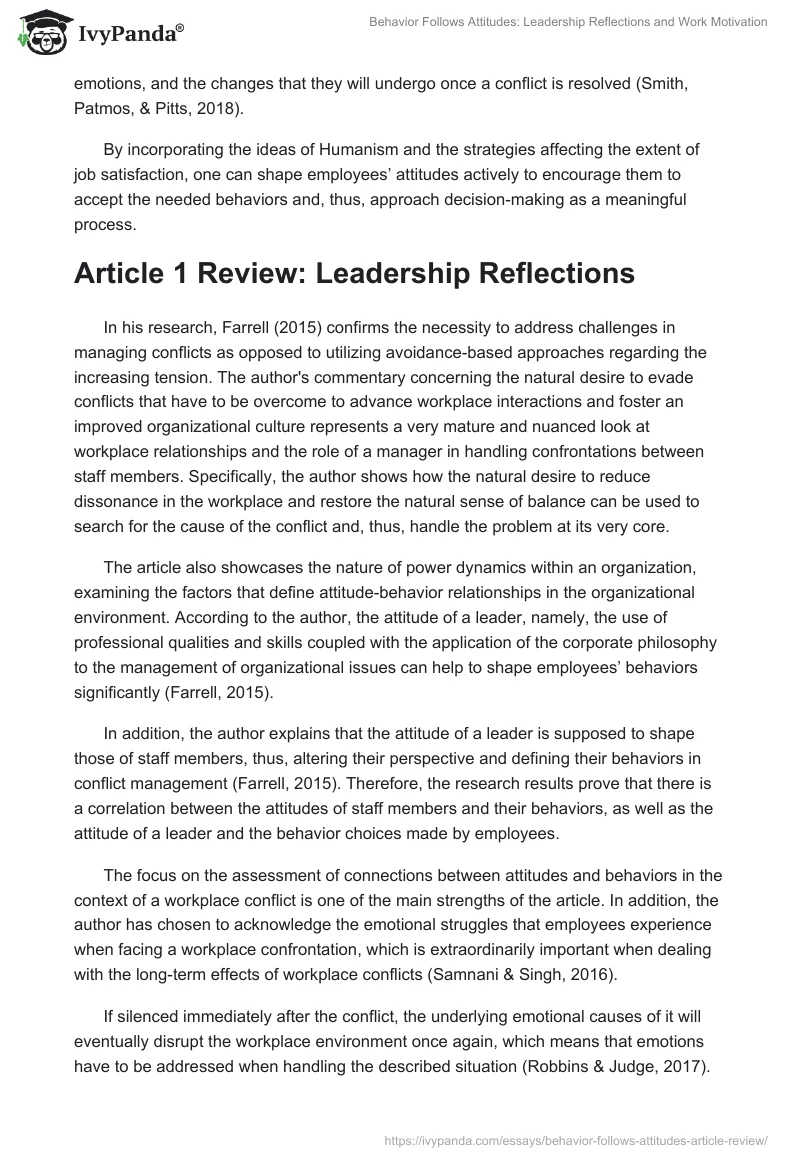Selected Concept: An Overview
Problem Statement
The idea of exploring behavior in the workplace and connecting it to attitudes toward key organizational values is not new, yet it introduces a manager to a plethora of insightful ideas concerning possible HRM techniques and especially the strategies for motivating employees (Tuna, Ghazzawi, Yesiltas, Tuna, & Arslan, 2016). In their articles, Farrell (2018) and Lăzăroiu (2015) study the connection between behaviors and attitudes. By examining the subject matter as a possible source of improvements in organizational performance should be seen as a necessity.
Workplace Behaviors, Conflict, and Humanistic Ideas
The problem of confrontations in the corporate environment is unfortunately common due to the differences in the viewpoints, philosophies, and values of the company members. Therefore, putting efforts into eliminating every possible premise for the conflict is barely reasonable, whereas the framework that could assist in disentangling workplace conflicts and assisting employees in reconciling seems a legitimately sensible goal (Deterding, 2019). The described objective satisfies the premises of Humanism as the idea of treating all people in a dignified and respectable manner. For this reason, exploring the facets of interpersonal and intrapersonal conflicts is needed.
The integration of inert- and intrapersonal perspectives into conflict management as the tools for giving participants more agency and a better insight into the nature of their disagreements should be recognized as a crucial aspect of the contemporary approaches toward handling confrontations in the organizational setting (Frémeaux & Michelson, 2017). The described framework implies deploying Humanistic principles to conflict management by recognizing the importance of the participants’ values, emotions, and the changes that they will undergo once a conflict is resolved (Smith, Patmos, & Pitts, 2018).
By incorporating the ideas of Humanism and the strategies affecting the extent of job satisfaction, one can shape employees’ attitudes actively to encourage them to accept the needed behaviors and, thus, approach decision-making as a meaningful process.
Article 1 Review: Leadership Reflections
In his research, Farrell (2015) confirms the necessity to address challenges in managing conflicts as opposed to utilizing avoidance-based approaches regarding the increasing tension. The author’s commentary concerning the natural desire to evade conflicts that have to be overcome to advance workplace interactions and foster an improved organizational culture represents a very mature and nuanced look at workplace relationships and the role of a manager in handling confrontations between staff members. Specifically, the author shows how the natural desire to reduce dissonance in the workplace and restore the natural sense of balance can be used to search for the cause of the conflict and, thus, handle the problem at its very core.
The article also showcases the nature of power dynamics within an organization, examining the factors that define attitude-behavior relationships in the organizational environment. According to the author, the attitude of a leader, namely, the use of professional qualities and skills coupled with the application of the corporate philosophy to the management of organizational issues can help to shape employees’ behaviors significantly (Farrell, 2015).
In addition, the author explains that the attitude of a leader is supposed to shape those of staff members, thus, altering their perspective and defining their behaviors in conflict management (Farrell, 2015). Therefore, the research results prove that there is a correlation between the attitudes of staff members and their behaviors, as well as the attitude of a leader and the behavior choices made by employees.
The focus on the assessment of connections between attitudes and behaviors in the context of a workplace conflict is one of the main strengths of the article. In addition, the author has chosen to acknowledge the emotional struggles that employees experience when facing a workplace confrontation, which is extraordinarily important when dealing with the long-term effects of workplace conflicts (Samnani & Singh, 2016).
If silenced immediately after the conflict, the underlying emotional causes of it will eventually disrupt the workplace environment once again, which means that emotions have to be addressed when handling the described situation (Robbins & Judge, 2017). The adoption of emotional intelligence and competence as integral parts of conflict management makes the article particularly strong, creating a people-oriented approach toward the problem.
Moreover, the proposed technique becomes the basis for boosting the levels of motivation in employees and increasing the extent of their loyalty to the company since the application of emotional intelligence allows building a rapport with staff members. Thus, the study invites opportunities for exploring the extent of influence that a leader can exert in an organizational setting to promote change (Yaacob & Long, 2015). The research suggests that the creation of positive direct personal experiences will help in building engagement and loyalty in staff members. In addition, the importance of recognizing the emotional baggage of employees and allowing them to explore their emotional connection to the company should be seen as highly important in boosting employee engagement levels.
Addressing possible weaknesses of the study, one should mention the lack of discussion of the limitations of the described solution. An in-depth exploration of the problems that the specified framework could entail, perhaps, with the inclusion of a case study, might have made the study even stronger. However, as it is, the article represents the subject matter quite accurately and produces important ideas, and allows for a nuanced interpretation of the connection between behaviors and attitudes in the workplace, as well as the factors that can be used to shape them effectively.
Article 2 Review: Work Motivation
Focusing on different aspects of workplace motivation, Lazaroiu (2015) extrapolates crucial standards for managing conflicts in the workplace by altering staff members’ perspectives and, thus, encouraging them to accept different behaviors. By examining different motivational frameworks used by leaders in an organizational environment, Lazaroiu (2015) concludes that motivation and, therefore, change in behaviors and attitudes, occurs as a result of engaging with employees on both emotional and cognitive levels. Thus, staff members are enabled to accept new workplace responsibilities and develop strong organizational commitment.
The nuanced approach toward the analysis of commitment and employee engagement from the standpoint of different motivational strategies is an undeniable strength of the article by Lazaroiu (2015). The paper delves into the advantages and disadvantages of people- and process-oriented frameworks for increasing motivation and workplace participation, which allows drawing connections between the changes in performative behaviors and alterations in employees’ attitudes. For instance, after scrutinizing some of the theories that promote process-oriented frameworks of motivation, Lazaroiu (2015) explains that the lack of emphasis on the factors defining the attitudes of employees may eventually bring the performance rates down.
In addition, the introduction of a dual perspective from which the issue of employee motivation, engagement, and loyalty can be analyzed, is one of the doubtless strengths of the paper. The research introduces multiple theories, yet the underlying notion of discontent coming from two types of factors, which are internal and external ones, remains one of the foundational ideas of the research. As a result, each of the theories adds to the understanding of how either employees’ perception of self and their place in the organization or the pressure of external factors such as the need to accept specific organizational values defines the attitudes and the resulting behaviors that staff members choose to adopt (Robbins & Judge, 2017).
For instance, the Expectancy theory that the authors select to describe as one of the tools for boosting the levels of staff performance establishes that the alterations in attitudes among staff members are a necessary step in encouraging positive change in their behaviors.
The author should be credited for outlining the major theories associated with staff motivation and behavior change in the workplace. Determining the key theoretical frameworks from which the phenomena of motivation and workplace engagement can be examined, Lazaroiu (2015) manages to outline the connection between changes in the attitudes that the introduction of specific HRM practices suggests and the alterations in employees’ behaviors.
The author examines six different theories that provide entirely different outlooks on the concept of workplace motivation and the methods of enhancing it in the organizational setting. However, the same principle of changing behaviors through the shift in attitudes, which, in turn, are shaped by an appropriate leadership framework, can be seen quite clearly in each theoretical perspective offered by the author. As a result, the importance of encouraging changes in employees by shaping their attitudes and promoting loyalty in them becomes evident.
However, the article also has several flaws that need to be addressed. For example, the lack of evidence from actual cases where the suggested theories are deployed to explain the changes in psychological empowerment of staff members and the development of organizational commitment in them is quite glaring (Fayankinnu & Ogungbamila, 2015). The incorporation of several case studies that would have shed light on the application of each theoretical framework would have been a welcome addition to the overall argument.
Conclusion
The introduction of humanistic principles into the management of workplace conflicts is essential since it leads to defeating the problem at its core and setting the pattern for conflict management in the future by changing attitudes and, therefore, behaviors of staff members.
The connection between the intrinsic beliefs that manifest themselves in workplace attitudes and the behavior-related choices becomes obvious when considering the effects of motivational leadership and the tools for helping employees to confront their emotions from both inter-and intrapersonal perspectives. To encourage the development of a better environment for staff members, one needs to consider the connection between attitudes and behaviors by introducing motivational techniques and assisting staff members in reconciling with their emotional responses.
References
Deterding, S. (2019). Gamification in management: Between choice architecture and humanistic design. Journal of Management Inquiry, 28(2), 131-136.
Farrell, M. (2015). Difficult conversations. Journal of Library Administration, 55(4), 302–311.
Fayankinnu, E. A., & Ogungbamila, B. (2015). Occupational burnout among head teachers in Nigeria: Consequences of job satisfaction and workplace commitment. Journal of Human Resources, 3(2), 29-41.
Frémeaux, S., & Michelson, G. (2017). The common good of the firm and humanistic management: Conscious capitalism and economy of communion. Journal of Business Ethics, 145(4), 701-709.
Lazaroiu, G. (2015). Work motivation and organizational behavior. Contemporary Readings in Law & Social Justice, 7(2), 66–75.
Robbins, S. P., & Judge, T. A. (2018). Essentials of organizational behavior (14th ed.). Upper Saddle River, NJ: Pearson Publications, Inc.
Samnani, A. K., & Singh, P. (2016). Workplace bullying: Considering the interaction between individual and work environment. Journal of Business Ethics, 139(3), 537-549.
Smith, S. A., Patmos, A., & Pitts, M. J. (2018). Communication and teleworking: A study of communication channel satisfaction, personality, and job satisfaction for teleworking employees. International Journal of Business Communication, 55(1), 44-68.
Tuna, M., Ghazzawi, I., Yesiltas, M., Tuna, A. A., & Arslan, S. (2016). The effects of the perceived external prestige of the organization on employee deviant workplace behavior: The mediating role of job satisfaction. International Journal of Contemporary Hospitality Management, 28(2), 366-396.
Yaacob, M., & Long, C. S. (2015). Role of occupational stress on job satisfaction. Mediterranean Journal of Social Sciences, 6(1), 81.


